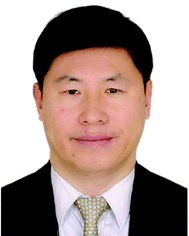2D nanomaterials: graphene and transition metal dichalcogenides
Hua
Zhang
*a,
Manish
Chhowalla
*b and
Zhongfan
Liu
*c
aCenter for Programmable Materials, School of Materials Science and Engineering, Nanyang Technological University, 50 Nanyang Avenue, Singapore 639798, Singapore. E-mail: hzhang@ntu.edu.sg
bMaterials Science and Engineering, Rutgers University, 607 Taylor Road, Piscataway, NJ 08854, USA. E-mail: manish1@rci.rutgers.edu
cCenter for Nanochemistry (CNC), Beijing Science and Engineering Center for Nanocarbons, Beijing National Laboratory for Molecular Sciences, College of Chemistry and Molecular Engineering, Academy for Advanced Interdisciplinary Studies, Peking University, Beijing 100871, People's Republic of China. E-mail: zfliu@pku.edu.cn
This themed issue is about two-dimensional (2D) transition metal dichalcogenides (TMDs) and graphene. Since Novoselov, Geim and co-workers successfully prepared graphene from graphite by mechanical exfoliation using Scotch tape in 2004, the past decade has witnessed explosive research progress in graphene and graphene-like ultrathin 2D nanomaterials, such as hexagonal boron nitride (h-BN), transition metal dichalcogenides (TMDs), graphitic carbon nitride (g-C3N4), black phosphorous (BP), silicene, MXenes and perovskites, among others. They all possess a sheet-like structure with a thickness of merely a single or few atomic layers, while the lateral size can be up to micrometers or even larger. As a result of the atomic thickness, high anisotropy and electron confinement in two dimensions, the physical, chemical, electronic and optical properties of 2D nanomaterials are strikingly fascinating and have stimulated tremendous research interests. For example, graphene is well-known for its intriguing properties such as its ultrahigh carrier mobility, exceptional electric and thermal conductivity, large specific surface area, excellent optical transparency, quantum Hall effect and high Young's modulus. Despite their similar layered structure features, the properties of different members in the 2D family can be disparate due to different compositions. For example, complementary to graphene, which is chemically inert and has no bandgap intrinsically, TMDs exhibit versatile chemistry and most of them have sizable bandgaps. The unique structural features and outstanding properties render the 2D family extremely popular and promising in fundamental studies and a wide spectrum of applications, such as (opto)electronics, energy storage and conversion, catalysis, biomedicine and sensors.
Although extensive research progress has been achieved in the field of 2D nanomaterials, such as the development of different synthetic methods, discovery of their structures and properties, and exploration of their potential applications, challenges still remain. Great efforts on pursuing precise control over their structures and properties and then realization of their practical applications never stop. Specifically, how to improve the existing synthetic approaches or develop new synthetic methods for scale-up production of 2D nanomaterials still requires great research efforts. Besides, obtaining precise control over their compositions, thicknesses, lateral sizes, crystal phases, doping, defects, strains, vacancies and surface properties becomes increasingly important to unveil the correlations between the structural features and properties. Significantly, recent years have witnessed great research efforts in the interface, defect and crystal-phase engineering of 2D nanomaterials. In addition, integration among various 2D nanomaterials to realize synergistic effects also deserves more research focus. We have seen the tip of the iceberg thanks to past contributions. It is time to step forward into an in-depth study and ultimately make these 2D nanomaterials indispensable in our real life. Targeting these goals, this themed issue attempts to present recent progress in studies mainly related to two kinds of 2D nanomaterials, i.e. TMDs and graphene, covering a wide range of topics. The following reviews are published in this themed issue.
The review article by Peng Chen and colleagues (DOI: 10.1039/c7cs00887b) presents works related to two-dimensional atomic crystals (2DACs) with single atomic thickness, including graphene, h-BN, TMDs, 2D alloys and beyond. To emphasize, the employment of the chemical synthetic method to prepare 2DACs is the focus of this review, highlighting its superiority over the conventional mechanical exfoliation method in terms of its robustness and scalability for practical applications. Additionally, the chemical synthesis of 2DAC heterostructures and superlattices is also reviewed, followed by the applications of 2DAC heterostructures in electronic and optoelectronic devices.
Ke Chen and co-workers (DOI: 10.1039/c7cs00852j) highlight the progress in the scalable production of three-dimensional (3D) graphene materials by the chemical vapour deposition (CVD) method. The 3D graphene materials refer to those integrated using graphene structural units, like foams, shells, hierarchical structures and beyond. Importantly, the use of the CVD method instead of solution-phase assembly is superior in terms of the ability to obtain products with high crystallinity and controllable layer numbers. In addition, the use of CVD-derived 3D graphene materials in various energy-related devices are demonstrated.
Xianglong Li and Linjie Zhi (DOI: 10.1039/c7cs00871f) report on the hybridization of graphene with diverse functions and components, with the aim to improve the performance of various energy storage devices including lithium-ion batteries, supercapacitors and beyond. Different hybridization principles and strategies are summarized for each specific energy storage device. Importantly, the synergistic effects provided by the graphene hybrids are highlighted, which not only provide the merit owed by each individual component, but also render them new functions and properties.
Xiaozhi Xu and co-workers (DOI: 10.1039/c7cs00836h) summarize recent theoretical and experimental advances related to bandgap opening in graphene. Despite its numerous outstanding features, the absence of an intrinsic bandgap limits the employment of graphene in semiconductor electronics. To this end, this article provides a comprehensive review on various strategies to achieve bandgap opening, which are categorized into two broad types, namely chemical engineering and physical engineering approaches. Importantly, the advantages and disadvantages of each method are highlighted and compared, offering a guideline for future improvement in bandgap opening and ultimate applications of graphene in semiconductor electronics and beyond.
Daniel S. Schulman and co-workers (DOI: 10.1039/c7cs00828g) provide a comprehensive overview of contact engineering. They emphasize the importance of high-quality contacts in 2D materials for their applications in various devices, and then summarize the recently developed strategies for contact engineering. Additionally, they highlight the phenomenon of Fermi level pinning and its possible origins and detrimental consequences. What is more, they also describe the characteristic features of a Schottky barrier FET as well as some possible approaches to mitigate its adverse effects on device performance.
Zehua Hu and co-workers (DOI: 10.1039/c8cs00024g) provide a comprehensive review on interface and defect engineering of 2D TMDs. They separately highlight the importance of different interfaces (e.g. the metal/TMD interface and the dielectric/TMD interface) as well as intrinsic defects (e.g. vacancies, adatoms, grain boundaries and substitutional impurities) in determining the device performance. Correspondingly, they summarize various interface and defect engineering strategies, in order to tune their properties and ultimately enhance the performance of electronic and optoelectronic devices.
In addition to the synthesis and advanced engineering of 2D nanomaterials, Shishu Zhang and co-workers (DOI: 10.1039/c7cs00874k) report on how Raman spectra can be utilized to obtain the structural and electronic band information of the as-obtained 2D materials. They provide a comprehensive summary of using Raman spectroscopic characterization to identify the in-plane anisotropy, defects, doping and stacking of the 2D nanomaterials. They also discuss the utilization of tip-enhanced Raman spectroscopy to obtain higher resolution and the Raman enhancement effect to probe the charge interaction between 2D materials and molecules.
Targeting a specific application, Fang Yi and co-workers (DOI: 10.1039/c7cs00849j) summarize recent advances in 2D material-based wearable energy sources, including wearable batteries, supercapacitors, and other energy harvesters. Importantly, they emphasize the critical roles that 2D materials play in enhancing the performance of different wearable energy devices. Additionally, the prospects and challenges of using these 2D materials for wearable energy sources are discussed.
Hua Zhang and coworkers (DOI: 10.1039/c8cs00094h) review the most recent important discoveries on the preparation, characterization and application of novel-structured ultrathin 2D layered TMDs, which are prepared especially by engineering their intrinsic structures at the atomic scale, including vacancy-containing TMDs, heteroatom doped-TMDs, TMD alloys, 1T′/1T phase and in-plane TMD crystal-phase heterostructures, TMD heterostructures, and Janus TMD nanosheets. These novel-structured ultrathin 2D layered TMDs exhibit unique properties and hold great promise in various applications including electronics/optoelectronics, thermoelectrics, catalysis, energy storage and conversion, and biomedicine.
Frisenda and co-workers (DOI: 10.1039/c7cs00880e) provide a comprehensive review on 2D material-based p–n junctions. They summarize different 2D p–n junction geometries, with a focus on vertical (out-of-plane) and lateral (in-plane) junctions as well as mixed-dimensional junctions. In addition, they also discuss different assembly methods to fabricate 2D p–n junctions, including top-down and bottom-up strategies, followed by their applications in electronic and optoelectronic devices.
The review article by Hasan and co-workers (DOI: 10.1039/c8cs00084k) presents applications of 2D materials in functional inks and printing. Specifically, the solution-processed 2D materials facilitate additive patterning on both rigid and conformable substrates, thus contributing to flexible device design and large-scale manufacturing. This review provides a good reference for utilization of graphene and related 2D materials in next-generation disruptive technologies and applications.
Wee and co-workers (DOI: 10.1039/c8cs00159f) report works related to the hybridization of 2D TMDs and organic molecules. They discuss the fundamental understanding of their interfacial interactions and the energy level alignment at the interface from both chemical and physical perspectives. To highlight, they specifically emphasize the surface charge transfer and electronic screening effects. Taking advantage of the synergistic effect, the applications of organic-2D TMD heterointerfaces in optoelectronics and p–n junctions are presented.
Garcia and co-workers (DOI: 10.1039/c7cs00864c) review the recent progress of graphene/TMD heterostructures in spintronics. TMDs, with large spin–orbit coupling and good interface matching, are considered to be promising complementary materials to enhance the spin-dependent features of graphene, at the same time maintaining their superior charge transport properties. They discuss both the theoretical and experimental measurements on spin–orbit coupling and spin currents in graphene/TMD heterostructures. To highlight, they emphasize several important phenomena in spintronics, including Hanle precession, weak antilocalization and the spin Hall effect.
In summary, this themed issue aims to provide the state-of-the-art progress in 2D nanomaterials with particular emphasis on recent advances. We believe that such a collection of comprehensive review articles covering broad topics related to 2D nanomaterials will become a valuable guideline for future development in this field. Finally, we would like to express our sincere gratitude towards the authors for their great contributions to this themed issue and the RSC editorial staff members for their strong support.
| This journal is © The Royal Society of Chemistry 2018 |



